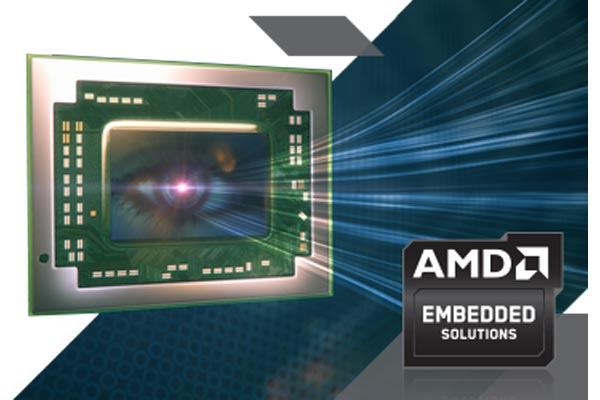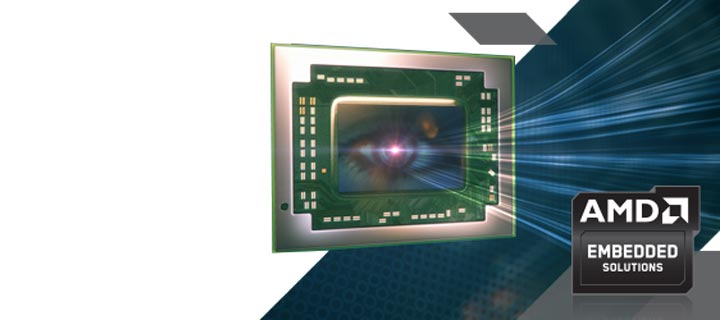New Embedded Single-Chip Offerings Deliver Superior Graphics, First DDR4 Memory Support
AMD (NASDAQ:AMD) announced new AMD Embedded R-Series SOC processors that establish performance leadership across a targeted range of embedded application market requirements for digital signage, retail signage, medical imaging, electronic gaming, media storage and communications and networking. Designed for demanding embedded needs, the processors incorporate the newest AMD 64-bit x86 CPU core (“Excavator”), plus third-generation Graphics Core Next GPU architecture, and state-of-the-art power management for reduced energy consumption. Combined, these AMD innovations and technologies provide industry-leading graphics performance and key embedded features for next-generation designs.

The single-chip system-on-chip (SOC) architecture enables simplified, small form factor board and system designs from AMD customers and a number of third party development platform providers, while providing astounding graphics and multimedia performance, including capability for hardware-accelerated decode of 4K video playback. With a robust suite of peripheral support and interface options, high-end AMD Radeon™ graphics, designed for the industry’s first Heterogeneous Systems Architecture (HSA) 1.0 certification, and support for the latest DDR4 memory, the new AMD R-Series SOC addresses the needs of a wide range of markets and customers.
“AMD continues its push into x86 embedded platforms and that’s paying off with an increasing number of customers and applications,” said Jim McGregor, principal analyst, TIRIAS Research. “There is a need for immersive graphics, high-quality visualization, and parallel computing in an increasing number of embedded applications. Across these fronts, the AMD Embedded R-Series SOC is a very compelling solution.
“With so much momentum around immersive experiences, especially for visual and parallel computing, the embedded industry needs a high-performance, low-power and efficient architecture with superior graphics and compute capabilities,” said Scott Aylor, corporate vice president and general manager, AMD Embedded Solutions. “Our new AMD Embedded R-Series SOC is a strong match for these needs in a variety of industries including digital signage, retail signage, medical imaging, electronic gaming machines, media storage, and communications and networking. The platform offers a strong value proposition for this next generation of high-performance, low-power embedded designs.”
Industry-Leading Graphics
With the latest generation AMD Radeon™ graphics as well as the latest multimedia technology integrated on-chip, the AMD Embedded R-Series SOC provides enhanced GPU performance and support for High Efficiency Video Coding (HEVC) for full 4K decode and DirectX® 12. The new AMD Embedded R-Series SOCs offer 22 percent improved GPU performance when compared to the 2nd Generation AMD Embedded R-Series APU and a 58 percent advantage against the Intel Broadwell Core i7 when running graphics-intensive benchmarks . Specifications for the integrated AMD Radeon™ graphics include:
- Up to eight compute units and two rendering blocks
- GPU clock speeds up to 800MHz resulting in 819 GFLOPS
- DirectX 12 support
Fully HSA Enabled
Customers in several industries such as machine learning, medical imaging and digital signage often need to execute compute intensive, parallel processing algorithms. HSA is a standardized platform design that unlocks the performance and power efficiency of the GPU as a parallel compute engine. It allows developers to more easily and efficiently apply the hardware resources in today’s SoCs, enabling applications to run faster and at lower power across a range of computing platforms. The AMD Embedded R-Series platform incorporates a full HSA implementation which balances the performance between the CPU and GPU. Leveraging the heterogeneous Unified Memory Architecture (hUMA) allows for reduced latencies and maximizes memory access to both the CPU and GPU to increase performance.
Designed for Embedded
The AMD Embedded R-Series SOC was architected with embedded customers in mind and includes features such as industrial temperature support, dual-channel DDR3 or DDR4 support with ECC (Error Correction Code), Secure Boot, and a broad range of processor options to meet an array of embedded needs. Additionally, configurable thermal design power (cTDP) allows designers to adjust the TDPs from 12W to 35W in 1W increments for greater flexibility. The AMD Embedded R-Series SOC also has a 35 percent reduced footprint when compared to the 2nd Generation AMD Embedded R-Series APU, making it an excellent choice for small form factor applications.
Key features and specifications include:
- First embedded processor with dual-channel 64-bit DDR4 or DDR3 with Error-Correction Code (ECC), with speeds up to DDR4-2400 and DDR3-2133, and support for 1.2V DDR4 and 1.5V/1.35V DDR3
- Dedicated AMD Secure Processor supports secure boot with AMD Hardware Validated Boot (HVB); initiates trusted boot environment before starting x86 cores
- High-performance Integrated FCH featuring PCIe® Gen3 USB3.0, SATA3, SD, GPIO, SPI, I2S, I2C, UART
- The AMD Embedded R-Series SOC provides industry-leading ten-year longevity of supply. The processors support Microsoft® Windows® 7, Windows® Embedded 7 and 8 Standard, Windows® 8.1, , Windows® 10, and AMD’s all-open Linux® driver including Mentor Embedded Linux from Mentor Graphics and their Sourcery CodeBench IDE development tools.
Liked this post? Follow SwirlingOverCoffee on Facebook.
Supporting Resources
AMD Embedded Processor product page
Learn more about the AMD Embedded R-Series SOC
Become a fan of AMD on Facebook
Follow AMD Embedded on Twitter
About AMD
For more than 45 years AMD has driven innovation in high-performance computing, graphics, and visualization technologies ― the building blocks for gaming, immersive platforms, and the datacenter. Hundreds of millions of consumers, leading Fortune 500 businesses, and cutting-edge scientific research facilities around the world rely on AMD technology daily to improve how they live, work, and play. AMD employees around the world are focused on building great products that push the boundaries of what is possible. For more information about how AMD is enabling today and inspiring tomorrow, visit the AMD (NASDAQ: AMD) website, blog, Facebook and Twitter pages.
AMD, the AMD Arrow logo, Radeon and combinations thereof, are trademarks of Advanced Micro Devices, Inc. DirectX, Microsoft and Windows are registered trademarks of Microsoft Corporation in the US and other jurisdictions. PCIe is a registered trademark of PCI-SIG Corporation. Other names are for informational purposes only and may be trademarks of their respective owners.
_____________________________
[1] HEVC acceleration is subject to inclusion/installation of compatible HEVC players. GD-8
2 The AMD RX-421BD (35W) processor scored 2720; the RX-427BB (35W) scored 2235. The score for the RX-421BD (2.1 GHz base, 3.4 GHz boost) was measured using an AMD Gardenia motherboard with 8GB of DDR3-2133 memory, a 250GB Samsung EVO 850 solid state drive (SSD), and graphics driver 15.101.0.0. The score for the RX-427BB (2.7 GHz base, 3.6 GHz boost) was measured using an AMD Ballina motherboard with 8GB of DDR3-2133 SO-DIMM memory, a Hitachi 256GB HDD, and graphics driver 13.350.0.0. Both systems ran Windows® 8.1 Professional. EMB-133
3 The AMD RX-421BD processor (configured for 15W TDP) scored 2190 and the Intel Core i7-5650U (15W) scored 1384. The score for the RX-421BD (2.1 GHz base, 3.4 GHz boost) was measured using an AMD Gardenia motherboard with 8GB of DDR3-2133 memory, a 250GB Samsung EVO 850 solid state drive (SSD), and graphics driver 15.101.0.0. The score for the Core i7-5650U (2.2 GHz) was measured using a Congatec TC97 module with 8GB of DDR3-1600 memory, a 250GB Hitachi HDD, and graphics driver 10.18.14.4139. The Intel system ran Windows® 7 Ultimate. The AMD system ran Windows 8.1 Professional. EMB-134
4 Discrete AMD Radeon™ and FirePro™ GPUs based on the Graphics Core Next architecture consist of multiple discrete execution engines known as a Compute Unit (“CU”). Each CU contains 64 shaders (“Stream Processors”) working in unison. GD-78


